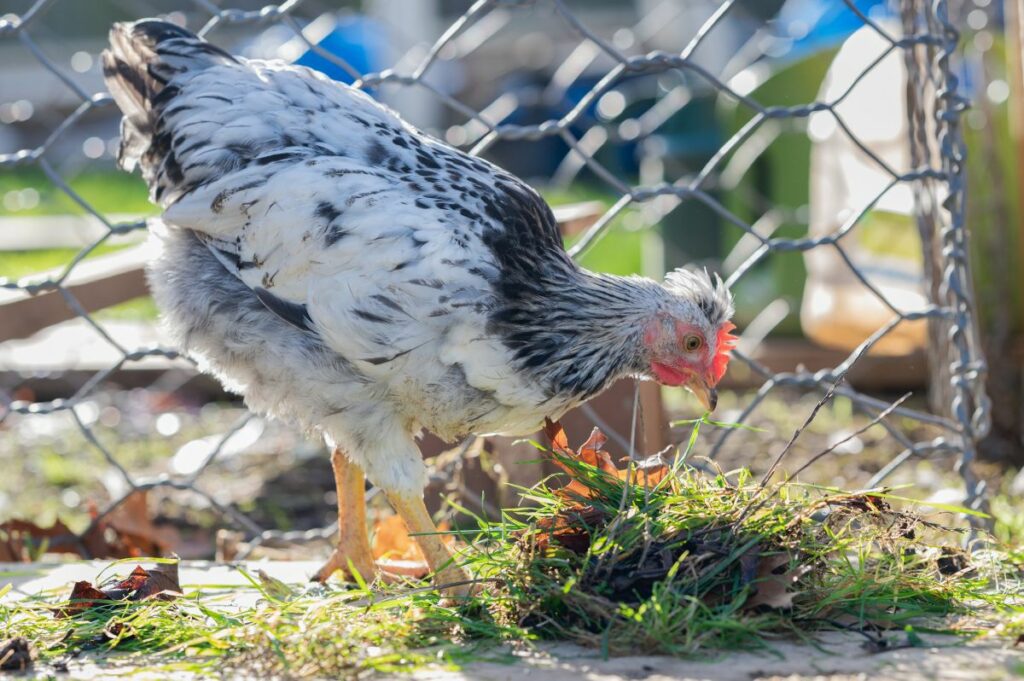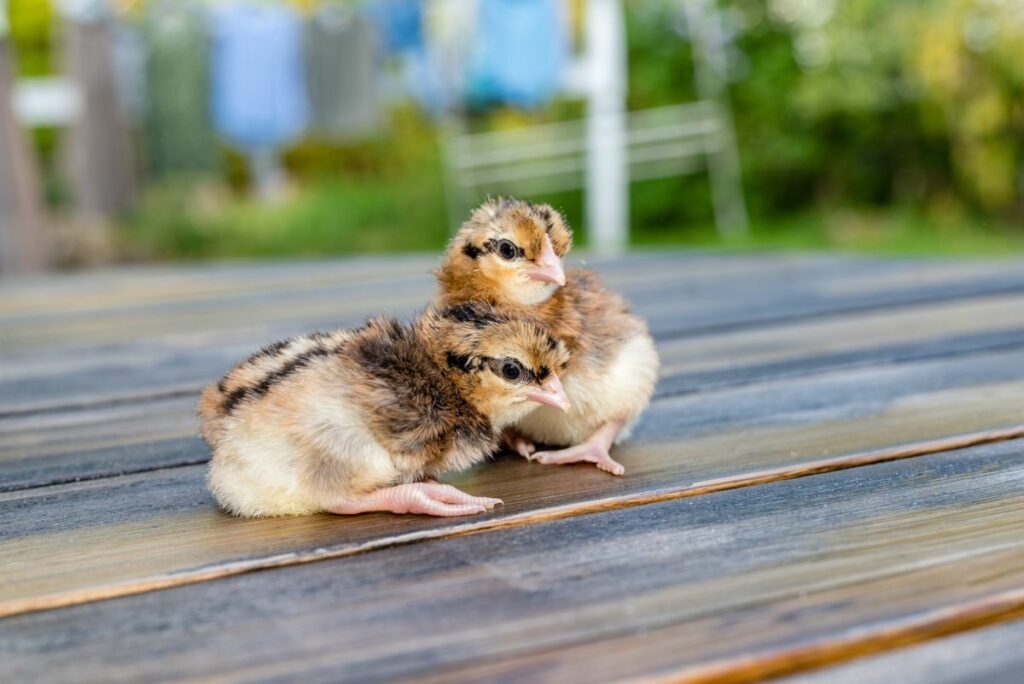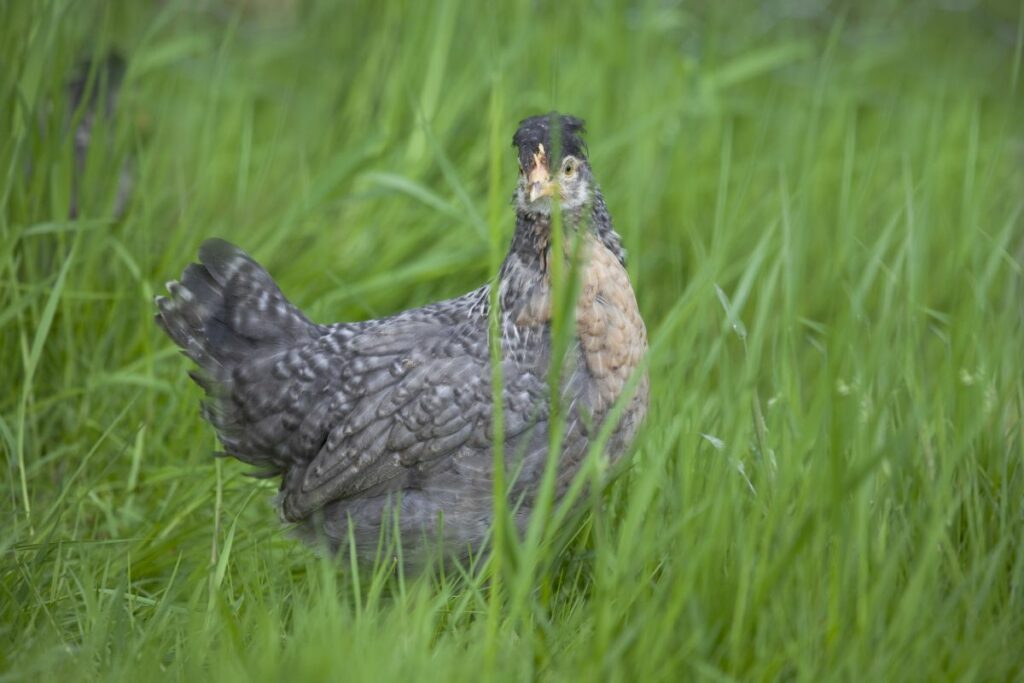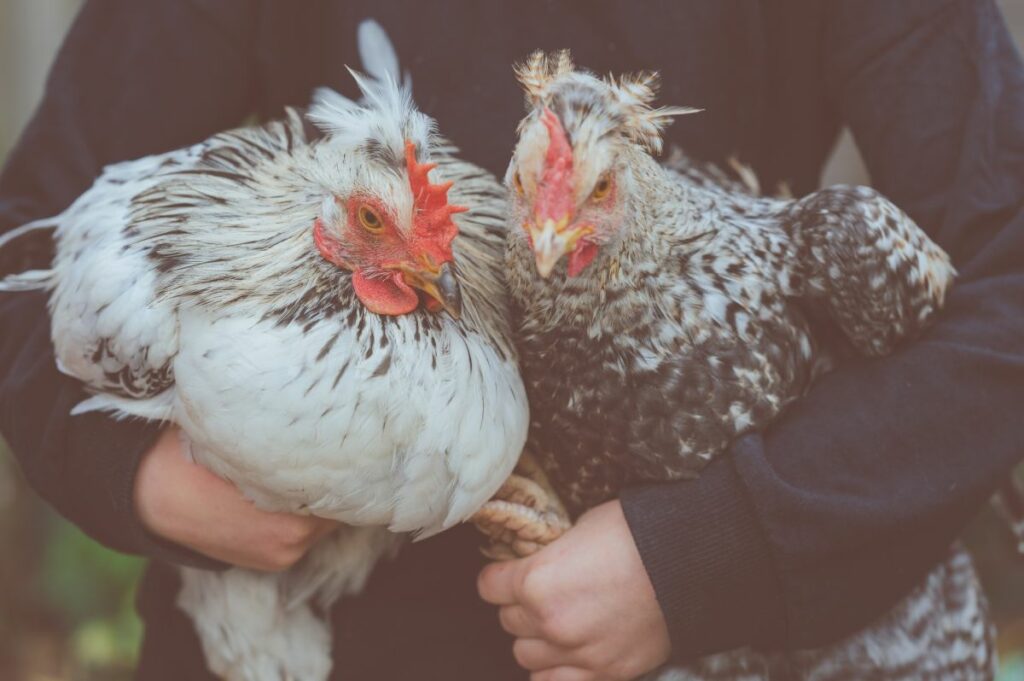The Cream Legbar chicken is a breed with a mix of gold, silver, and cream feathers, but many people are more interested in their beautifully colored eggs.
If you’re looking for an easy-going chicken breed that’s also great for egg production, these Legbars might be ideal for you, but like all chickens, they have some specific care requirements.
Cream Legbar Overview

Here’s a quick overview of this breed’s traits before looking at the details of its care.
| Lifespan | 5 to 10 years |
| Weight | 5.5 to 7.5 pounds |
| Appearance | Gold, silver, or cream feathers |
| Egg Production | 4 eggs per week, about 230 per year |
| Egg Color | Blue |
| Good for Beginners? | Yes |
| Minimum Coop Size | 4 square feet per bird |
| Price | $5 to $10 per chick |
Cream Legbar Chicken History
The Cream Legbar chicken breed came into existence in 1931. Professor R.C. Punnett and Professor Michael Pease first bred the chicken in Cambridge, England.
At the time, other Legbars already existed. Legbars were the second “auto-sexing” breed to exist, which means their sex can be determined as chicks.
When Professor Punnet obtained a few South American Araucanas, he was impressed by the blue eggs they laid. He decided to cross-breed them with other birds, and when he bred South American Araucanas with Gold Penciled Hamburgs, he got a beautiful cream-colored chicken that laid blue eggs.
Around the same time, Professor Pease also discovered that two different breeds could create a cream-colored bird. So, the two professors worked together to create the Cream Legbar chicken.
It’s unclear exactly which breeds created Cream Legbars, but it’s suspected to include Plymouth Rocks, Leghorns, and Araucanas.
The first time this breed was exhibited was at the London Dairy Show in 1947. Many people fell in love with the chicken’s unique appearance, but in the 1970s, Cream Legbars almost went extinct because people weren’t purchasing “novelty” eggs enough.
Luckily, the breed survived and is still in high demand today. Chicken keepers often purchase them for their unique feathers, blue eggs, and great egg production.
Appearance

Cream Legbars are the most common variety of the Legbar chicken breed. Here’s what they look like at every life stage.
Cream Legbar Egg Color
These chickens lay medium-sized pastel blue eggs. Only the outside of the egg is blue, and the inside is the same color as any other chicken egg.
Cream Legbar Chick Appearance
You can tell the difference between male and female chicks are soon as they hatch. Most of their feathers will be light yellow, but the markings are what distinguishes the two sexes.
Within hours of hatching, females will develop dark stripes around their face and a white spot on the back of their head. Male Cream Legbar chicks have much lighter coloring. If you purchase female Cream Legbars from a breeder, you’ll know you’re getting female chicks.
Adult Apperance
The feathers of an adult Cream Legbar are usually a mix of cream, gray, and gold. Hens often have lighter coloring than roosters.
These chickens have a triangular-shaped body with a tail that sticks upright. They have a single red comb, and their legs and beaks are yellow.
Most of these birds have feathers sticking up behind their combs, which is why they’re sometimes called Crested Cream Legbar chicks and chickens.
Size and Weight
Cream Legbars are medium-sized birds. The hens weigh about 5.5 pounds while the roosters weigh about 7.5 pounds.
Cream Legbar Chicken Temperament
Most Cream Legbars are docile and friendly, but the personality can greatly vary based on the bird. Some keepers have described them as nervous, skittish chickens, but those characteristics are less common. Most of them don’t mind approaching humans and being handled.
Since there’s some discrepancy about which breeds create Cream Legbar chicks, these birds can pick up different qualities depending on who their parents are. So, before buying chicks from a breeder, ask them about how the chicks were bred and what qualities the parent breeds had.
These chickens tend to be more curious and aware of their surroundings than other breeds. They’ll be quick to run for cover if they see a predator, and they will alert the rest of the flock of threats.
Noise Levels

Cream Legbars are average when it comes to noise levels. They’ll make typical chicken sounds like cackling and clucking, but they won’t cause too much of a disturbance.
Cream Legbar roosters can be a bit noisy, and they may crow loudly. So, if you’re bothered by noise, avoid getting a rooster unless you want to breed your hens.
Broodiness
Broodiness is uncommon for these chickens, but it depends on the individual bird. A few Cream Legbars might have a desire to raise their eggs and chicks, but most of them will leave it up to you.
Can They Live with Other Birds?
Cream Legbar chickens are rarely aggressive with other animals, so they can live with birds of other species. A mixed-breed flock with chickens of similar sizes and temperaments is ideal for this breed.
Just make sure you avoid larger, more dominant birds because otherwise, your Cream Legbars might get picked on.
Care
Most beginners can handle Cream Legbars, but all keepers need to research a breed before adding it to their flock. Here are some tips for how to care for these beautiful birds.
Feeding
Feed your birds a layer feed that has between 15% and 19% protein. When they’re chicks, you can give them a chick feed with extra protein, but transition to them to an adult feed as they enter their pullet stage.
Cream Legbars thrive if they’re allowed to free-range. Free-ranging means the chickens can roam freely during the day so they can forage. As long as they have access to food and water, they’ll return to the coop at night. The coop is a safe space for them, so they won’t run away from it unless a predator chases them away.
Free-ranging helps chickens get extra nutrients that they won’t find in pellets or feed. They can gain those nutrients from various plants and invertebrates. Foraging also prevents boredom in chickens and helps reduce the number of pests on your property.
Coop Setup

Cream Legbars only need about four square feet per bird in the coop, but you can always give them more if you’re able. Each chicken should also get about 12 inches of roosting space. In the summer, they’ll spread out across their roosting space, but in the winter, they might huddle on one roost to keep warm.
You’ll also need one nesting box for every four hens. Standard sized nesting boxes (12 x 12 x 12 inches) is ideal for this breed. Anything bigger can cause hens to squeeze together in one box, which could break the eggs.
Since they’re natural foragers, they should be allowed to free-range when outside the coop. They can be confined if the space is big enough, but small enclosures will make them restless. If you have to confine them, make sure there’s at least 10 square feet of run space per bird.
If you keep a fence around the run space, you should give them some free-range time now and then. Staying in confinement too long will make these birds a flight risk in the future. If you don’t feel comfortable letting your birds roam free, you may want to consider a different chicken breed.
Temperature
Cream Legbars can be tolerant to all types of temperatures, but they don’t handle cold weather as well as hot weather. If you live somewhere that gets cold in the winter, you may want to use a coop heater.
Even though this breed does fine in the summer, you should take extra precautions with all chickens in the heat. Make sure their coop is well-ventilated and provide lots of shade outside. Always give them access to fresh water, no matter how hot or cold the weather is.
Health Concerns
These birds aren’t prone to many specific health concerns, but like all chickens, they can get ill if not properly cared for. So, here are some conditions to look out for.
Parasites
Parasites like lice and mites can infest all chicken breeds. They can hide in your chicken’s feathers and spread to other birds in your flock.
Check your chickens for parasites on occasion and clean the room regularly to avoid infestations. That includes wiping down surfaces and cleaning food and water bowls. You can also get preventatives from a vet to reduce the risk even further.
Sour Crop
Since Cream Legbars love to forage, they’re more likely to get a sour crop. A sour crop occurs when a chicken’s crop gets clogged or isn’t draining properly. If they eat too much long, stringy grass, it could cause a blockage in the digestive tract
To reduce the risk, trim grass around the coop and remove any potentially hazardous items, such as litter and anything else that isn’t edible.
Head Injuries
Some birds might pick at other crested breeds. So, be cautious when introducing young birds to the flock. Adult chickens might peck at the heads of young Cream Legbars, causing a brain injury since the skull isn’t fully formed yet.
Closely monitor your birds during introductions and separate them until you’re sure they won’t bully each other.
Egg Production

The Cream Legbar chicken egg production is about four eggs per week, which ends up being 200 to 230 eggs per year.
These birds start laying eggs at about six months old. Some of them lay eggs year-round, but other may stop laying eggs in the winter if it’s too cold.
Frequently Asked Questions
If Cream Legbars seem like ideal chickens for you, you might be curious about the following questions.
There are lots of reputable breeders that have Cream Legbars for sale. Look for a breeder that’s knowledgeable about the breed so you can make sure you’re purchasing healthy chicks. The cream coloring of this chicks can be uncommon, so consider other variants if Cream Legbars aren’t available near you.
Yes, Cream Legbars are hybrids that were created by mixing other chicken breeds together, so a lot of their traits are uncertain. For example, their lifespan is a wide range because the chickens vary so much and how they’re cared for has a huge impact on how long they live.
The Cream Legbar chicken breed is a beautiful bird with unique blue eggs. These birds are most commonly used for egg production, and they’re docile enough for beginners to handle.
These birds can have a wide variety of traits, depending on how they were bred. So, thoroughly research breeders and care requirements before bringing some of these chickens into your flock.
